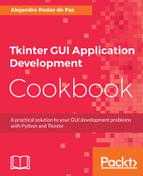These types of entries are added with the add_checkbutton and add_radiobutton methods of the Menu widget class. Like with regular radio buttons, all are connected to the same Tkinter variable, but each one sets a different value:
import tkinter as tk
class App(tk.Tk):
def __init__(self):
super().__init__()
self.checked = tk.BooleanVar()
self.checked.trace("w", self.mark_checked)
self.radio = tk.StringVar()
self.radio.set("1")
self.radio.trace("w", self.mark_radio)
menu = tk.Menu(self)
submenu = tk.Menu(menu, tearoff=0)
submenu.add_checkbutton(label="Checkbutton", onvalue=True,
offvalue=False, variable=self.checked)
submenu.add_separator()
submenu.add_radiobutton(label="Radio 1", value="1",
variable=self.radio)
submenu.add_radiobutton(label="Radio 2", value="2",
variable=self.radio)
submenu.add_radiobutton(label="Radio 3", value="3",
variable=self.radio)
menu.add_cascade(label="Options", menu=submenu)
menu.add_command(label="Quit", command=self.destroy)
self.config(menu=menu)
def mark_checked(self, *args):
print(self.checked.get())
def mark_radio(self, *args):
print(self.radio.get())
if __name__ == "__main__":
app = App()
app.mainloop()
Additionally, we are tracing the variable changes so you can see the values printed on the console when you run this application.
